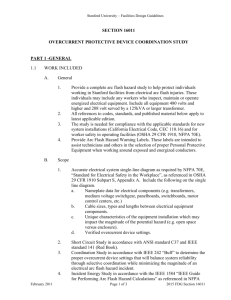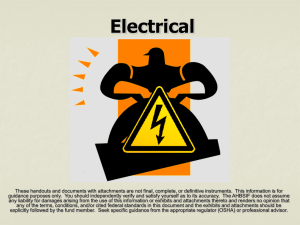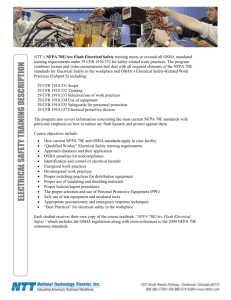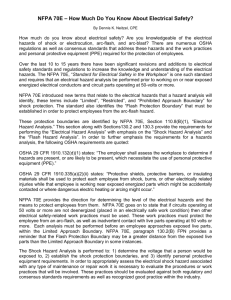NFPA 70E 2012 Rolls Out New Business-Critical Continuity
advertisement
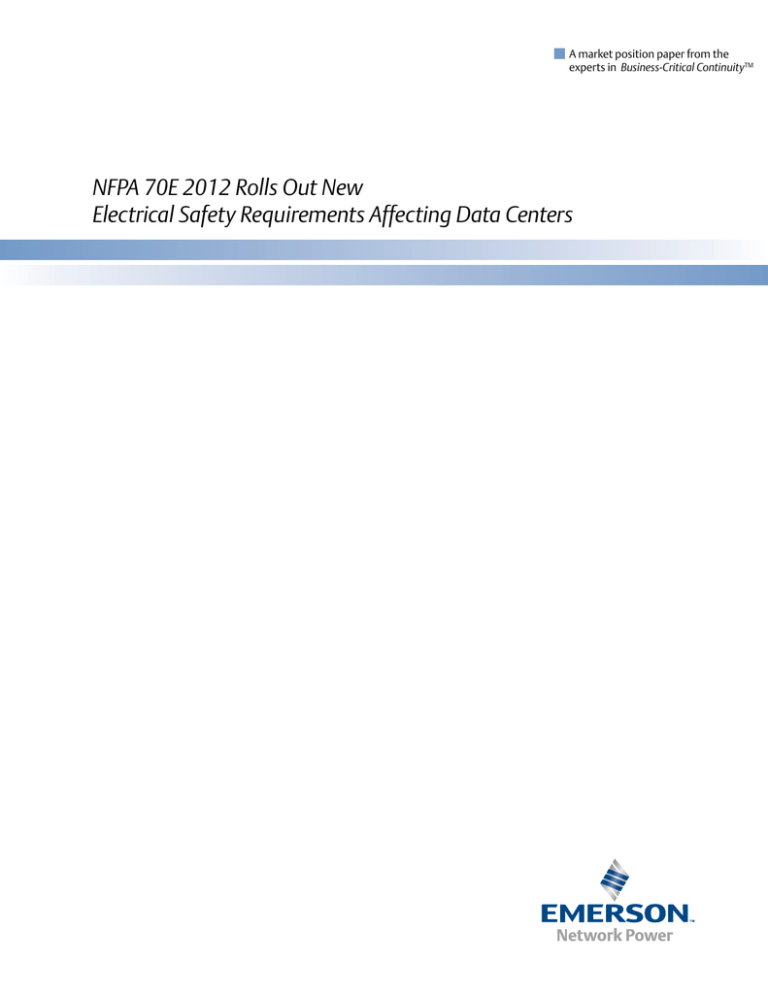
A market position paper from the experts in Business-Critical ContinuityTM NFPA 70E 2012 Rolls Out New Electrical Safety Requirements Affecting Data Centers Executive Summary Electrocutions are the fourth leading cause of traumatic occupational fatalities. Every day, one person dies in the workplace from electrocution, and the United States averages more than 3,600 disabling electrical contact injuries annually, according to the American Society of Safety Engineers. To help prevent electrical accidents, the new 2012 version of the National Fire Protection Association (NFPA) 70E: Standard for Electrical Safety in the Workplace® makes significant changes in the areas of safety, maintenance and training. While the importance of electrical safety is clear, understanding the complex regulatory requirements can be difficult. This paper provides an overview of the safety and maintenance changes that most impact data centers; discusses challenges to implementing electrical safety programs; and shares best practices for an effective program for data centers. 2 OSHA + NFPA: Regulating Workplace Safety The U.S. Occupational Health and Safety Administration (OSHA) provides the legal requirement for employers to provide a safe work environment, and its regulations are enforceable under federal law. It sets general requirements for safe work practices, personal protective equipment (PPE) and hazard analysis. The NFPA is the world’s leading advocate of fire protection and has published more than 300 consensus codes and standards. Together, OSHA and NFPA are working to ensure safe working conditions. Although OSHA outlines general requirements, in many cases it does not detail how to achieve them. This is left to national consensus standards such as NFPA 70 National Electrical Code and NFPA 70E Standard for Electrical Safety in the Workplace. For example, OSHA requires the use of protective equipment when working where potential electrical hazards exist, and NFPA 70E identifies the hazards and describes the measures that can be taken to prevent electrical injuries. NFPA standards are not federal standards, however, they are used as part of electrical safety practices and are referenced as part of an OSHA citation. NFPA 70E outlines the specific safety procedures and practices to be followed when working on live equipment. The standard covers safety-related work practices associated with electrical energy during activities such as installation, inspection, operation, maintenance and demolition of electric equipment. NFPA 70E Changes Affecting Data Centers The 2012 Edition of NFPA 70E became effective August 31, 2011, making significant changes that require data center managers to take action. The following pages outline the relevant changes: • Safety-Related Work Practices (article 110) • Work Involving Arc Flash Hazards (article 130) • General Maintenance Requirements (article 250) Safety-Related Work Practices Most data center managers already comply with the requirement that employers meet with contractors to communicate known hazards and information about installation that the contractor needs to make assessments. New in NFPA 70E, however, article 110.1(C) requires this meeting to be documented. The new standard also adds muscle to its provision that employees who work around (not just on) energized electrical equipment must be safety trained. Article 110.2(D)(1)(f) requires employees to perform annual inspections to ensure each employee is complying with all safety-related work practices outlined in 70E. And article 110.2(D)(3) newly requires that employees be retrained at intervals not to exceed three years, while 110.2(E) states that the training content must be documented. What’s more, data center owners must now audit their safety training program and field work at least every three years to ensure it complies with 70E [110.3(H)(1) and (2)]. The audit must be documented and revisions made to the safety program if any elements are not in compliance [110.3(H)(3)]. Regarding use of equipment, article 110.4 now specifies that only qualified persons perform testing and maintenance within the limited approach boundary. According to OSHA 1910, the definition of qualified includes required training, demonstrated skills, and knowledge of installation and hazards. The standard also now includes use of GFCIs where required by local, state and federal codes or standards. 3 Work Involving Arc Flash Hazards Arcing from an electrical fault produces temperatures that can easily exceed 30,000°F — hotter than the surface of the sun. Air expands dramatically when heated to these temperatures, and arcing also causes metal conductors to vaporize. Copper, for example, expands 67,000 times when it is converted from solid to vapor. The rapid expansion of air and metal vapor produces an incredibly hot blast with force similar to an explosion — enough to throw a worker’s body across the room. Too often employees who are not wearing adequate PPE are seriously injured or killed if an electrical arc occurs when they are working on electrical equipment. IEEE reports that 2,000 workers are admitted to burn centers for extended injury treatment caused by arc flash each year. Even someone standing more than 10 feet from the fault source can be fatally burned. The problem is severe enough that IEEE and NFPA have joined forces on an initiative to fund and support research and testing to increase the industry and public awareness of arc flash. Arc flash labeling became a 70E requirement in 2002. These requirements were updated in 2004, 2009 and 2012. While many data centers have implemented the basic 70E hazard label requirements, the new standard includes expanded requirements for labels. Data centers that have not been vigilant in their labeling may need to create new arc flash hazard labels. NFPA 70E 130.5(C) states labels now must include nominal system voltage, arc flash boundary, and at least one of the following: incident energy and corresponding working distance; minimum arc rating of clothing; required level of PPE; or highest Hazard/Risk Category (HRC) for the equipment. In addition 130.5(C) states: “The method of calculating and the data to support the information for the label shall be documented.” In the past, the standard was ambiguous about whether it was sufficient to use tables supplied by 4 the standard for the arc flash boundary distance (flash protection boundary) or whether the distance would have to be calculated. The lack of clarity was often used to justify the easier method of using the tables instead of the more accurate method of calculating the distance. Several provisions in the new 70E make it much more difficult to defend using tables, however: • Article 130.5(A) replaces the previous fourfoot default value for arc flash boundary with the statement: “The arc flash boundary for systems 50 volts and greater shall be the distance at which the incident energy equals 1.2cal/cm2.” The practical implication is that the arc flash boundary distance must now be calculated for all locations where the voltage is greater than 50 volts. (See below for exception.) • In article 130.7(C)(15)(a) and 130.7(C) (15)(b), arc flash boundary values have been inserted as part of the task category headings, but the table includes complex footnotes regarding applicability. So without performing a short circuit and coordination study, it would be very difficult to know whether the table is applicable. Yet if such a study is performed, it would take little additional effort to determine calculated flash boundary values, in which case, the table values would not be needed. Arc flash boundary values are not provided for the DC table, Table 130.7(C)(15)(b). In addition, NFPA 70E 2012 now requires arc flash labeling for DC equipment. Previously, Table 130.2(C) provided approach boundaries for various voltage levels; however, it did not distinguish between AC and DC equipment locations. The new Table 130.4(C)(a) provides approach boundaries for AC equipment locations, and Table 130.4(C)(b) provides approach boundaries for DC equipment locations. Although DC flash hazard can be severe, NFPA 70E 2009 did not specifically address this hazard. The Hazard Risk Category (HRC) Table 130.7(C)(9) of the 2009 edition did not distinguish between AC and DC equipment locations. New Table 130.7(C) (15)(b) shows HRC values for DC locations. But for the reasons mentioned above, calculating the HRC values is a preferable approach. Equations used by state-of-the-art software for calculating DC arc flash values are shown in Section D.8 of NFPA 70E 2012. Using such software would be the preferable method for determining incident energy and HRC. While an industry standard previously was not in place, DC equipment labeling is now a requirement. Although not new in 2012, it bears reminding that article 130.5 requires updating the arc flash analysis when any major modifications or renovations take place and that it shall be reviewed periodically, not to exceed 5 years to account for changes. General Maintenance Requirements New to NFPA 70E are requirements for conducting maintenance on electrical equipment. Prior to this edition, it was only specified for overcurrent protective devices. Article 205.2 states that a single-line diagram, where provided for the electrical system, shall be maintained in a legible condition and shall be kept current; 205.3 requires electrical equipment to be maintained in accordance with manufacturers’ instructions or industry consensus standards to reduce the risk of failure and the subsequent exposure of employees to electrical hazards. In addition, documentation is now required (article 205.4) for overcurrent protective devices to show they have been maintained, tested and inspected in accordance with manufacturers’ instructions or industry consensus standards such as ANSI/NETA 2011 Standard for Maintenance Testing Specifications and NFPA 70B Recommended Practice for Electrical Equipment Maintenance. Challenges to Implementing Workplace Electrical Safety Requirements The majority of data centers work to comply with NFPA 70E. In some instances, however, data center managers seeking to implement these safety requirements face internal challenges. Lack of resources can be one challenge, but misconceptions also can prevent full compliance, specifically the beliefs that: 1. Electrical hazards are not really a problem. 2. Labeling is not required if the company mandates that electrical systems must be deenergized before working on them. In light of the changes to 70E, and the high levels of fault current and incident energy that is typically present in data centers with multiple or parallel power sources, it is more important than ever for data center owners to understand the requirements and work to comply. All Electrical Systems Covered by NFPA 70E Must Be Labeled It is without exception that all electrical systems covered by NFPA 70E must be labeled. Inevitably, maintenance and/or testing will be performed on the electrical system. Workers must test and verify that the system is de-energized. Until all six steps outlined in Article 120.1 have been achieved, including the lockout/tagout procedure, the equipment is considered to be energized. Therefore, all workers must be informed of the level of PPE necessary for the job, which requires performing a flash hazard analysis. Article 130.2 B (1) states: “When working within the limited approach boundary or the arc flash boundary of exposed energized electrical ... work to be performed shall be considered energized electrical work and shall be performed by written permit only.” It goes on to outline eight required elements that must be included in the written work permit. Performing a flash hazard analysis 5 is a prominent element of the required activities. Article 130.5 states: “An arc flash hazard analysis shall determine the arc flash boundary, the incident energy at the working distance and the personal protective equipment that people within the arc flash boundary shall use.” • Substations, switchgear assemblies, panelboards, motor control centers, disconnect switches Data Center Electrical Safety Program Model • Fuses and circuit breakers Electrical hazards in the workplace can have devastating effects. Establishing an effective safety program compliant with NFPA 70E will: • Equipment in hazardous locations • Reduce injuries and fatalities • Portable electric tools and equipment • Reduce lost worker productivity • Personal safety and protective equipment including electrical gloves, hot sticks and flash suits • Avoid higher insurance costs and costly fines • Promote optimum system performance and efficiency Unfortunately, ensuring compliance with NFPA 70E can be a difficult task to accomplish in-house without the assistance of resources familiar with industry standards and recommended practices. The right partner will be able to develop and implement a complete, cost-effective solution – from arc flash calculations to personal protective equipment (PPE) recommendations to ongoing preventive maintenance. Emerson Network Power recommends the following elements and best practices as part of a comprehensive, effective electrical safety program that complies with OSHA, NFPA and other relevant industry organizations. Preventive Maintenance Maintaining all of your data center electrical equipment is critical to ensuring worker safety and preventing unplanned downtime. NFPA 70E specifically requires electrical equipment and overcurrent protection devices be maintained. Such equipment would include: 6 • Insulated conductors, grounds and busduct • Transfer switches and control equipment • Motors and generators • Batteries and battery rooms Arc Flash Hazard Analysis The NFPA 70E guidelines require facility owners to perform an arc flash hazard analysis prior to allowing a worker to perform a task on energized equipment. The arc flash analysis identifies the presence and location of potential hazards and provides recommendations for PPE, boundaries for limited, restricted and prohibited approaches, recommendations for flash protection, and safe work practices. To calculate incident energy, technical data is reviewed and additional data is collected such as equipment type, voltage, ratings, impedance and other information. To provide accurate results, state-of- the-art software should be utilized to perform the arc flash calculations. The software enables users to evaluate alternatives quickly and easily to establish an optimal design. Arc Flash Hazard Labeling Electrical equipment such as switchboards, panelboards, industrial control panels, and motor control centers that are likely to require maintenance while energized, must be field marked with a label. Specific requirements for what must be included are outlined in NFPA 70E 103.5. Site Review/Compliance Assessment OSHA can and does enforce the NFPA 70E guidelines. The best way to meet necessary requirements is to conduct a comprehensive facility assessment to identify areas of risk and non-compliance, and then formulate a plan to bring your facility into compliance in the most efficient way possible. Design and Methods Review A protection scheme design review and operational assessment of your electrical distribution system should be conducted to identify and reduce potential electrical hazards. Several areas to evaluate include fault current levels, arc exposure times, operational procedures (such as remote breaker control and remote racking) and system grounding. Experts can assist with mitigation strategies to alter the current design, which can significantly reduce fault levels, arcing time, arc incident energy and arc blast force. Single-Line Diagrams NFPA 70E requirements mandate accurate, up-to-date and legible single-line diagrams. These documents are essential for documenting, troubleshooting, and communicating information about your power systems. A comprehensive site survey is essential to develop or update existing single-line diagrams or complete electrical system drawings. Short Circuit and Coordination Studies To achieve the most accurate arc flash hazard results, it is recommended that arc flash calculations be completed in conjunction with short circuit calculations and protective device coordination. Short circuit and coordination studies calculate momentary, interrupting and arcing current values, compare available fault currents to protective device ratings, and establish trip settings for all types of protective devices minimizing downtime for your entire power distribution system. It’s important to select an expert that specializes in conducting these studies to ensure compliance with NFPA and OSHA requirements. Electrical Safety Program Review/Development An effective safety program should be designed to provide training and awareness of the potential electrical hazards to employees. It should also identify hazard/risk evaluation procedures, electrically safe work procedures, tools and PPE, and risk mitigation strategies. The electrical safety program must be documented and audited at least every three years to verify the principles and procedures are in compliance with NFPA 70E. Conclusion The danger has increased. The demands of continuous operation require data centers to have multiple or parallel power sources resulting in higher levels of fault current and incident energy. Therefore, data centers are dynamic environments that can be very dangerous if not managed correctly. Organizations such as OSHA and NFPA have become more proactive to establish standards and regulations to ensure worker safety. Staying on top of the complex regulatory requirements can be difficult to accomplish with internal resources only. By partnering with a qualified service provider, data center managers can rely on people familiar with industry standards and recommended best practices to ensure compliance. 7 Emerson Network Power Liebert® Services 610 Executive Campus Dr. Westerville, OH 43082 614 841 6400 Phone 614 841 6405 Fax EmersonNetworkPower.com Customer Resolution Center 800 LIEBERT (543 2378) While every precaution has been taken to ensure accuracy and completeness in this literature, Emerson Network Power, Inc. and Emerson Electric Power Co. assume no responsibility, and disclaim all liability for damages resulting from use of this information or for any errors or omissions. Emerson Network Power, Inc. is a division of Emerson Electric Power. SL–24665 (R06-12) Printed in USA Emerson Network Power The global leader in enabling Business-Critical Continuity™ AC Power Connectivity DC Power Embedded Computing Embedded Power Industrial Power Infrastructure Management & Monitoring Outside Plant Power Switching & Controls EmersonNetworkPower. com Precision Cooling Racks & Integrated Cabinets Services
